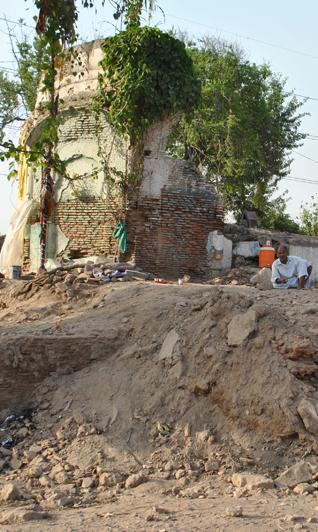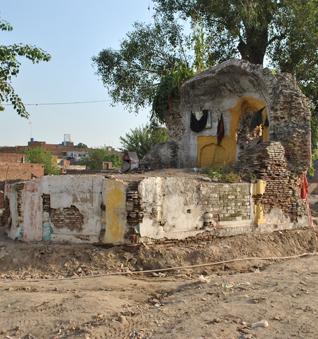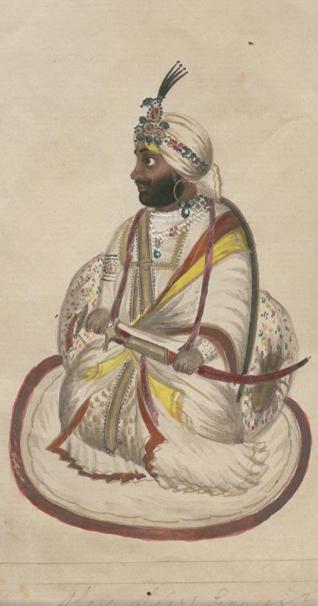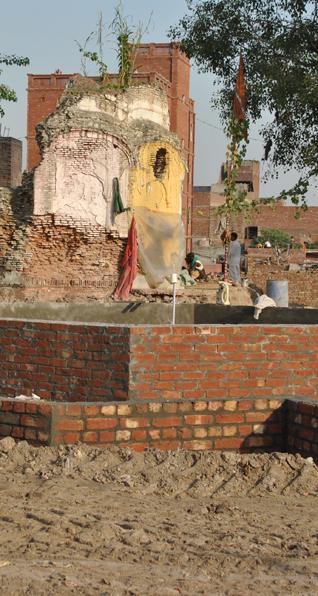Architecture
The Samaadh of Maharaja Sher Singh
Text and Photography by AOWN ALI
samaadh - a sepulchre or funerary monument raised over the ashes of a deceased person, usually a personage.[Dictionary]
In Lahore (Punjab, Pakistan) the samaadh of Maharaja Sher Singh and his son Kanwar (heir apparent) Partap Singh is another one of the many Sikh monuments here that are in ruins and close to disappearing altogether.
The reasons for this predicament vary, but the impending fate and the looming danger is sadly shared by much of the Sikh architectural
heritage located in Punjab, Pakistan.
Located
in southern Lahore, locally known as Kot Khwaja Saeed, the samaadh of
the Maharaja and the Crown Prince is situated in the vicinity
of a baaraa-dari (mansion) of Maharaja Sher Singh, which is also known locally as the baaraa-dari of
Shah Bilawal, a local Sufi saint.
Maharaja Sher Singh, who ruled Punjab from January 1841 until his death in September 1843, was a son of Maharaja Ranjit Singh.
He was born on 4 December 1807 to Maharani Mehtab Kaur.
On 15 September 1843, Maharaja Sher Singh rode out of the city early in the morning. He alighted near Tej Singh’s garden where tents were put up for his son Kanvar Partap Singh. The Maharaja moved on to the baaraadari where he witnessed a wrestling performance.
When he had dismissed the wrestlers, the Sandhanwalia Sardars, who had followed him with 150 horse and 300 foot soldiers, requested him to inspect a parade of their troops. Totally without suspicion, Sher Singh agreed and came out of the baaraadari. After the parade, Ajit Singh Sandhanwalia sought the Maharaja's consent to present a carbine. As the latter reached out to take hold of the weapon, Ajit Singh pulled the trigger of the loaded gun.
"Oh, Sardar, what treachery?" was all the Maharaja could say as he dropped to the ground, dead.
Ajit Singh rushed forward and cut off his head.
The
shots that killed Sher Singh were a signal for Lehna Singh Sandhanwalia
to pounce upon Kanvar Partap Singh, then seven years old.
Maharaja Sher Singh and Kanvar Partap Singh were cremated at the same site of the baaraadari, where later their samaadh was erected.
According to local historian Iqbal Qaisar, the author of "Historical Sikh Shrines in Pakistan", the samaadh was built by Rani Randhawi, wife of Sher Singh.
“The samaadhs of Rani
Randhawi, Dharam Kaur and Rani Partap Kaur were also located on the
same site; the samadh of the Rani was on the eastern side of Maharaja Sher
Singh's samaadh, whereas the one on the western side housed the ashes of the others. These samaadhs had domes where the cremated ashes were kept,”
explains Iqbal Qaisar.
The Samaadhs of Maharaja Sher Singh and his family members are now close to complete collapse.
The year 1992 proved very unfortunate for much of our architectural heritage.
The criminal attack by Hindu fundamentalists on a mosque in Ayodhya in India, instigated by the then Hindu right-wing BJP Government, caused a stream of retaliation and vandalism in Pakistan against Hindu temples and monuments in Pakistan.
However, sadly, some of the vandalism was misguidedly directed against Sikh historic buildings, which happened to be more significant and prominent than the others.
The Baaraadri and the Samaadh of Maharaja Sher Singh were among those buildings which were seriously damaged by the mobs in 1992.
Miscreants oblivious of the historic significance, attacked and knocked down the baaraadri and the samaadh, wrongly assuming it to be a Hindu temple complex. A large number of people living in the area of Kot Khwaja Saeed, where this baaraadari and samaadh are located, still believe them to be a Hindu temple complex.
Interviews with many of the residents of the neighbourhood lead to the conclusion that most of the attackers who ransacked the complex were merely led by greed and looted the finely carved and valuable wooden structure including doors, windows
and roof of the buildings. Therefater, they occupied the ruins and land.
Historical notes and research by Iqbal Qaisar and others reveal that there were several samaadhs located a short distance from the baaraadari - of the Maharaja, the Crown Prince and two Ranis.a, Maharaja Sher Singh himself and his son.
There were tomb-like domed structures covering a large area on the west of the baaraadari.
Although not entirely intact, most of the samaadh’s building structure remained stable till early 1992. But now we find the western wall of the building, a few feet wide, and some remains of a demolished building adjacent to it.
There is nothing else to mark it as the tomb structure of a family
which once ruled the great Empire which.extended to Tibet in the east, to
the Khyber Pass in the west, to Kashmir in the north and to Sindh in the
south.
Currently, both the samaadh and the baaraadari are sandwiched between the Kot Khwaja Seed District Headquarter Hospital and a doctors' and nurses' hostel. A portion of the mansion area was recently converted a public park by the Parks and Horticulture Authority of Lahore.
Yet, there are no plans to restore the samaadhs or the baaraadari, or to conserve what is left.
I
fear that the site is rapidly heading towards one of two possible fates: either the
historical buildings will be minimally "restored" to the extent that much
of their original character will be compromised, or the buildings will end
up totally destroyed due to ongoing encroachment, squatting, construction, dilapidation,
improper management, etc.
The
author, a photojournalist based in Lahore, Punjab, Pakistan, is particularly
interested in documentary photography. He has photographed dozens of
significant historic architecture and archeological sites in Pakistan
and Afghanistan. His photographic work is mainly displayed at www.orientalarchitecture.com.
His work, including photo stories and research, is widely published
in Pakistani newspapers, magazines and websites. He is currently working
on the Sikh architectural heritage located in Lahore and other cities
of Pakistan.
November 19, 2011
Conversation about this article
1: S.K. (USA), February 13, 2014, 6:42 AM.
It's a pity that such monuments of national and historical value are being vandalized just on the pretext of religion and historical wounds. The government should take up and develop these for tourism so that they can generate income, develop tourism and raise the living standard of all those living around. In addition to preserving our precious heritage.






